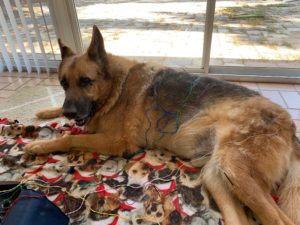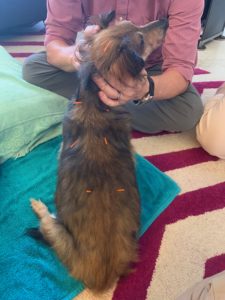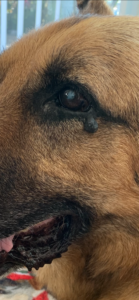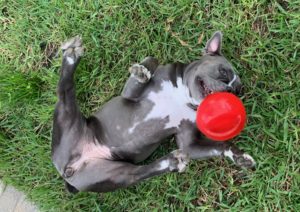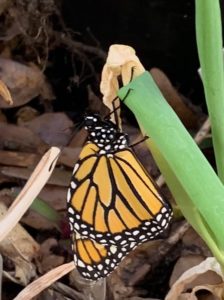Doggone Anesthesia
2010 September 24
by virtuavet
How do I avoid Anesthesia for my Older Dog?
Anesthesia can age an already older pet. There may be groggy hours or days of recovery, digestive upset, stiffness or achyness from positioning during the procedure. You may be wondering if anesthesia is the only way to go? And if it is, what can you do to help your dog bounce back better than before the anesthesia? A holistic house call veterinarian with over 20 years experience, Dr Truli offers tips and alternatives you may not have already thought of.
-
Get a second opinion
- After 20 years of surgeries, Dr Truli’s Tampa Bay area practice is now 100% house calls with no surgery. “If I recommend surgery, I make zero money from that recommendation. You know I truly feel the surgery is in your pet’s best interest,” says Doc Truli.
-
Get a proper diagnosis
- diagnosis: vomiting versus regurgitation “Vomiting involves active abdominal retching. If it ‘just comes up’ especially after your pet has just been sleeping, it is likely regurgitation. Why does it matter? If it is vomit, we look in the abdomen for the problem. If it is regurgitation, we look in the chest,” says Doc Truli. You might be getting x-rays of the wrong part of the body!
- diagnosis: diarrhea versus constipation “Diarrhea and constipation can look identical. Your dog is doing the squat-walk around the yard and nothing comes out. Most people assume it is constipation. Usually it is diarrhea. Opposite treatment,” says Doc Truli.
- diagnosis: coughing versus choking “Coughing can look like choking. Choking is a life-threatening emergency. If you think your dog is choking, do not hesitate to go to the pet ER,” Doc Truli.
- diagnosis: bacterial skin infection versus yeast infection versus skin cancer “Bacteria, yeast, ringworm, mites and skin cancer can look identical. You need proper non-invasive testing,” says Doc Truli.
-
Ask explicitly about alternatives to surgery
- alternative: new medical treatments “Will acupuncture work just as well as or better than surgery?” asks Doc Truli. What else might work?
- alternative: rest and painkillers “Does the surgery improve the outcome, or is it the same? Many times knee surgery can be avoided with rest, painkillers and physical techniques like professional massage and exercises for healing,” sys Doc Truli.
- alternative: how many dogs get better on their own? If you do nothing, will your dog get better? The classic example is ear hematoma surgery. A dog will likely get better on its own without surgery, but it can be painful and take longer than if you have a surgery performed.
-
Can the procedure be done with local numbing?
- local anesthesia reduces need for deep anesthesia
- many skin tags and small lumps and skin biopsies can be performed with local numbing. A calm, complaint dog that does not mind laying on a table under surgical lights is the ideal patient for non-anesthesia procedures.
- your dog needs help to decrease anxiety and pain with local anesthesia “Local anesthesia numbs the sensation from the area. But most dogs do not understand the hospital environment and feel anxious. Anxiety increases perception of pain,” says Doc Truli
- local anesthesia reduces need for deep anesthesia
-
Can the procedure be done with light sedation?
- light sedation: lump removal small lumps in a calm dog, especially on an easy to heal area like the trunk of the body or the top of the head are candidates for non-anesthesia surgery
- light sedation: diagnostic testing
- ultrasound usually no sedation is needed. Some dogs fidget or pant and must have a light sedative so the ultrasonographer can see the computer images.
- allergy skin testing is performed with light sedation. It may be more difficult to explain to your itchy dog why they are being shaved in a dermtologist’s office than explaining skin testing to your child.
- diagnostic biopsy, especially bone marrow biopsies can be quite painful and scary. Sedation is considered necessary for bone marrow biopsies.
-
Does my dog need anesthesia?
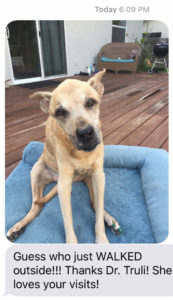
This girl would likely not survive surgery. Happy Patient after massage, acupuncture and injections to help severe arthritis & weakness.
- anesthesia: would the procedure be less stressful for my dog?
- tumor removal in a nervous dog. Will your dog remember the procedure and never accept a veterinarian’s help again unless zonked by sedation? Perhaps it is better to let your dog sleep through this episode, instead of developing a mental complex.
- anesthesia: would the procedure be faster?
- if your dog needs to be held still. Think about your dog standing and sitting, standing and sitting, panting, spinning, while your veterinarian tries to suture closed an incision on your dog’s side. It is likely to take an hour instead of 10 minutes!
- anesthesia: would the results be better?
- more thorough visualization
- ability to move the body parts and get to the area “I admit, back in the day, sometimes I wish I would have put certain dogs under anesthesia instead of taking 4 nurses and an hour to do a 1 nurse 10 minute procedure with only local anesthesia,” says Doc Truli.
- is the procedure impossible without anesthesia?
- dental x-rays. Nope. No. It is not possible to take diagnostic quality dental x-rays in an awake dog. Why? If you ever had dental x-rays, remember when they said, “Now hold your breath for a minute?” That’s why.
- painful surgeries: bone, knee, hip, back. Just grueling. Only battlefield conditions would make me want to do these surgeries without anesthesia.
- anesthesia: would the procedure be less stressful for my dog?
-
What can I expect my dog to go through if they do not have the surgery?
- Always ask yourself and your veterinarian: is the surgery better the problem in the first place? For example, bilateral mastectomy on a 12 year old dog with pre-cancerous lumps. An intensive, extensive large surgery might make her weaker.
- “I saw a dog years ago with a large red lump on the top of his nose. It was a mast cell tumor. Surgery was needed to cure it. But the family did not want his nose disfigured and frankly, it was an expensive surgery. The dog lived 3 more happy years, then suddenly passed from cancer-related disease. 15 was pretty good!” says Doc Truli.
Call or email Dr Truli today! Call toll-free (877) 378-7854 or email DrTruli@VetVMD.com
No comments yet

